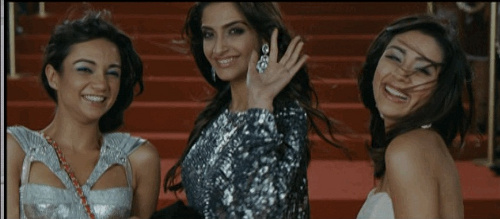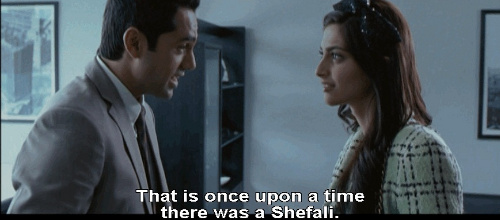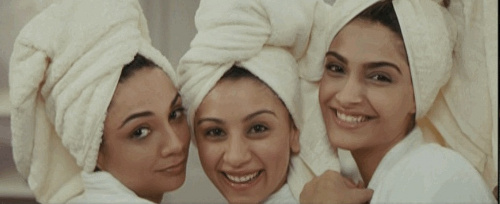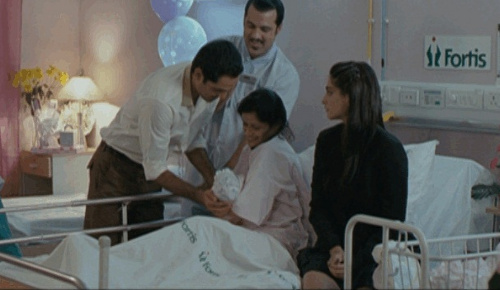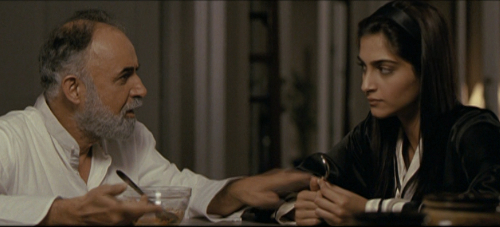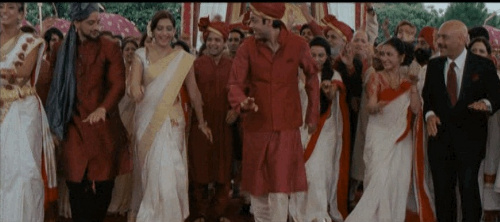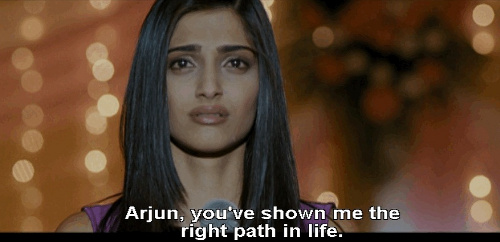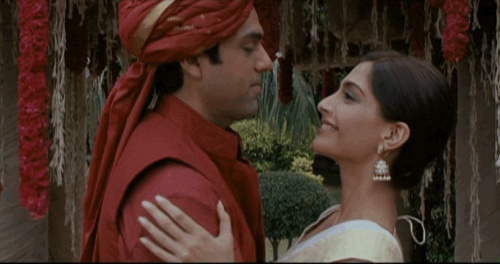|
a yellow VW careens along the highways of Delhi, nearly colliding with oncoming traffic and almost ripping off the door of the car by which it parks: Emma arrives late to the wedding of Miss Taylor—or is it Cher failing her driving test in the neverland of 1990s L.A.? No, it is Aisha rushing to the marriage of her aunt, the Miss Taylor of the 2010 Bollywood film, Aisha. Aisha has been accused of relying so heavily on the Alicia Silverstone Clueless that it scarcely deserves the distinction of being called an adaptation of Austen’s Emma (cf. Crouch). Though Aisha does cite its film predecessors almost unceasingly, these include the Gwyneth Paltrow Emma as well as classic Bollywood films like Kuch Kuch Hota Hai (Something is Happening), Kabhi Khushi, Kabhi Gam (Sometimes Happy, Sometimes Sad) and Dilwale Dulhania le Jayenge (The Brave Heart Carries Away the Bride). Aisha is thus not entirely Clueless. Though like Cher Horowitz, Aisha is a spoiled modern urbanite, director Rajshree Ojha and screenwriter Devika Bhagat seem more aware than was Amy Heckerling of the problems involved in setting Austen’s novel in a city. If the recent Indian movie is less exuberant and energetic than the Hollywood product, it nevertheless adheres more closely to some elements of Austen’s plotting and characterization, and above all presents an intelligent and, eventually, reflective heroine whose heart awakens to its own love of virtue, loyalty, and care as manifested in the long-known and thus unrecognized hero.
Both the older and the more recent British productions of the novel have capitalized on the English countryside that Austen’s heroine so clearly relishes living in: “It was a sweet view—sweet to the eye and the mind. English verdure, English culture, English comfort, seen under a sun bright, without being oppressive” (Emma 360). Jane Austen’s Emma is a rural heroine: though at the top of her society’s social ladder, she nonetheless is not a cosmopolitan, worldly socialite. That Emma’s world is small and limited is one of the important features of the novel; Austen’s themes depend in part upon the setting. The novel Emma has been called Austen’s English pastoral, but Aisha, set in 2010 New Delhi, is pointedly urban, with locations in CP (Connaught Place) and Defence Colony, both regions of the city associated with wealth and privilege, nowhere near an Abbey Mill Farm or, indeed, a Donwell Abbey. When this version relocates the heroine to an enormous, busy metropolis, we need to consider whether the story survives in any essential way. If Emma ceases to be the queen of English verdure and becomes the empress of a cosmopolitan Indian scene, can we say that this Bollywood Emma is still in any way Austen’s Emma?
If Juliet McMaster is right about the novel’s offering us the geography of Emma’s mind, then what is irretrievably lost with the English landscape and the small roads of Highbury, the sense of London being several hours’ ride away, is precisely the most important thing about Emma herself, her mind, a word that Austen often uses to indicate even the larger concept of soul (cf. Ryle 17-18). A film version can hope to grant the watcher some sense of that countryside, some sense even of Emma looking upon it. A film version that changes the setting in terms of time or place cannot. Thus, Emma’s mind was certainly not on display in Clueless, a movie that not only presented the clever if constantly wrong heroine as an airhead, but also placed her in a cartoonized version of a Los Angeles high school amid shopping malls and busy highways. Aisha likewise frequents shopping malls and drives on massive highways, and the only greenery in sight is her lovely little garden that she, like Gwyneth Paltrow’s Emma but not like Austen’s, tends sporadically. Removed from Emma’s own time and space, the geography of her mind can hardly be similar, or at least, can hardly be read as reflected in the landscape surrounding her.
Even should we say that the heart of an adaptation’s authenticity ought to be its fidelity to the plot, not its setting, Aisha might as well be an update of It Happened One Night, The Taming of the Shrew, or A Midsummer Night’s Dream1 as of Emma. Aisha is the spoiled heiress who needs to come to heel and see the reasonableness and desirableness of the man in her life; a parade of young lovers seems to switch partners until all settles down into the most satisfactory pattern. These bare bones of the plot are not recognizably Austenian, even if Austen made use of them. Recognizable scenes from Austen’s plot pull the movie back into Austen’s orbit: the visit of Mr. Knightley to the Woodhouses after Miss Taylor’s wedding; Emma’s deprecation of Robert Martin; Mr. Knightley’s castigating of Emma for her taking up Harriet as an inferior companion she may manipulate; Mr. Elton’s dreadful proposal to Emma; and Harriet’s renunciation of her treasures amassed over weeks of contact with Mr. Elton. There are many more. Though the dialogue is certainly changed from the novel, these set pieces mark Emma’s progress through her story, and they allow the film to resonate Austen’s realism, her building of character and of tensions in relationships. They also develop her themes of self-delusion, class consciousness, and noblesse oblige.
The director and screenwriter also manage to recreate the sense of a strictly limited social group and constricted geography in the urban setting; perhaps one of the greatest successes of the Indian film is that it is able to take what is for its Indian audience a well-known city and give viewers the sense of its heroine inhabiting a world of only ten or twenty families in which the slightest intrusion from outside can upset the social balance. It is, however, Aisha herself, rather than her location, imposing such enclosure. She is the center of the geography of Aisha, and though the film roams from shopping malls to camping trips, there is, as in the novel, almost never a time when Aisha is not our focalizer and our main concern.
Aisha, like its Hollywood prototype, narrows its focus to Aisha’s lack of self-knowledge and her heedless domination of her friends, but Sonam Kapoor’s Aisha is not otherwise very much like Cher: she is more a compound of Austen’s supercilious but sociable Emma, Kuch Kuch Hota Hai’s boisterous Anjali, Dilwale Dulhania le Jayenge’s standoffish Simran, and Kabhi Khushi Kabhi Gam’s preening Pooh (whose sari Shefali, or Harriet Smith, admires so much), as well as a standard spoiled little rich girl. She is thus more complex than Cher, perhaps because her creators are less sure that Emma can survive being transplanted from English to foreign soil.
The name Aisha itself was carefully chosen: “Aisha” means the one who is alive. Though Austen did not envision Emma as some kind of life force, her liveliness, misguided though it is, drives the action of her novel. It is not Emma’s imagination alone that conceives of Highbury as circling around her. Thus the actress playing her must engage her society’s attention as well as ours, even if she will clearly lose our sympathy at certain points in the story. Sonam Kapoor, the film’s Aisha, made her debut as the melancholy and mysterious heroine in the disappointing Saawariya (My Love), a remake of an earlier adaptation of Dostoevsky’s “White Nights,” a film that convinced viewers of her beauty but not her depth or talent. She was upstaged in Saawariya; she holds her own as Aisha. Significantly, the name Aisha does not indicate perfection, as Mr. Weston so gallantly claims the name Emma does (at just the wrong moment), but it is as redolent of ancient queens as Austen’s heroine’s name.2
In keeping with her name, Aisha dominates her society as Emma does, through her position and her sense of self. The film captures Emma’s arrogance and snobbery, rendered less offensive by habitual kindness of address and real affection for her family and close friends. Aisha, however, does not make the mistake of either the very successful 1995 Clueless or the less well-loved 2009 BBC Emma of presenting us with an infantile “airhead” as a heroine. This Emma, perhaps because a director and one producer are family members who want to showcase the actress’s talent, is vain (unlike Austen’s Emma) but not stupid.3 (The Miramax Emma may also have influenced the makers of the film in this regard.) With all its defects, after a most unpromising beginning, Aisha succeeds in giving us a young and intelligent but indulged and privileged woman who does not know her own heart and who innocently (but not blamelessly) plays with the lives of others in a way that eventually hurts both them and herself.
However, no one involved seems to have noticed the novel’s insistence on Emma’s lack of vanity, a virtue that Mr. Knightley emphasizes in his debate with Mrs. Weston over Emma’s merits, and that Austen highlights again in later scenes such as when Emma quickly gets over being upstaged at her own ball by Mrs. Elton’s leading the dance. Whereas Austen never shows us Emma thinking about her wardrobe, Aisha is, like Cher in Clueless, a clothes horse, and the costume designer and star both confessed to wanting to feature high fashion in the movie. Too often, the first half of the movie seems like nothing more than a L’Oreal or Dior commercial, and it is accordingly somewhat dull, a less imaginative Clueless with the added influence of Sex and the City. Film critic Jennifer Hopfinger laments, “All we learn from Aisha about wealthy Delhiites is that they’re fabulously well-dressed.” Aisha is merely following Clueless’s lead in the attention it gives to the heroine’s fashion sense.
This focus on the trappings of wealth is a trend in recent Bollywood films that has received criticism from Indian audiences; Bollywood has caught the heritage film disease of featuring ever-larger houses and absurdly improbable wardrobes, parties, and transport, and the result is a glitter-fest completely alien to the restrained and tasteful habit of wealth and comfort that make up the Hartfield and Donwell Abbey of the novel. Aisha at times seems embarrassingly nouveau-riche. No one could accuse Austen of writing about houses, clothes, and fashion instead of the conduct of human beings. The medium of film might demand visual indications of wealth and status, but surrendering the quaint and traditional Ford’s for the glossy spaces of a shopping mall makes Aisha something Austen’s Emma is not: a heroine of surfaces and mirrors. Even the urban setting did not require the creation of such a mental geography.
And what of the hero of the film, its Mr. Knightley? Rising actor Abhay Deol plays the role of Arjun Burman. The name Arjun means “white, clear” or “shining,” obviously a fine choice for a Hindi Mr. George Knightley, with all the name’s Western resonances of saintliness and chivalry. Aisha’s Mr. Knightley is not, however, a gentleman farmer or landholder but an investment banker, the younger, not the older brother. There is no question of primogeniture here, only money and education (“So what if he graduated from Wharton?” a fuming Aisha asks). Deol, only thirty-five during the filming, is a youthful and extraordinarily wealthy version of the landed but not very wealthy Austen hero. In contrast to Clueless’s pretentious college student, this Mr. Knightley is a polo-playing playboy, an adept salsa dancer, and a fan of very long legs. Arjun does not charm in the first half of the film, and not just for the reason Austen’s preachy, stolid Mr. Knightley might not. Aisha’s first words to him, criticizing his constant indulgence in designer suits, sets the wrong tone—as if Mr. Knightley would expend huge sums on his wardrobe (or on polo ponies). His boast, in his first appearance, that he has a “sixteen pack” underneath his designer suit seems a stroke of sexual vanity beneath the decorous Mr. Knightley, and his relationship with business associate Aarti (the film’s Jane Fairfax), who fondles his posterior at Aisha’s version of the Crown Ball, seems a bit sordid and distances him from his prototype.
However, Deol eventually convinces as the old neighbor who is very much at home in the Kapoor house and very much used to having a hand in correcting Aisha. Though the first half mostly features the two main characters bickering loudly in the fashion of another movie couple who are inspirations for the film, Rahul and Anjali of the Karan Johar hit Kuch Kuch Hota Hai, he conveys the maturity and solicitude of Austen’s character well. By the end—and the second half gives him much more to do than the first—Deol has truly made the Mr. Knightley role his own: courteous, even when angry with Aisha, self-sacrificing, concerned for others, deeply unsettled by Aisha’s relationships with Shefali (Harriet Smith) and Dhruv (Frank Churchill), and sensing his own part in nearly warping Aisha’s character.
Both lead actors grow on the viewer, and when the script does give them the chance, they are able eloquently to portray the concern, the jealousy, the growing interest, and the joy Aisha and Arjun take in each other. Deol also shows signs of being more than capable of portraying Mr. Knightley’s jealousy, self-abnegation, and even that return to preachy taskmaster with which Austen slyly ends her novel of “improvement.” The film does not give him enough opportunities.
Although Clueless virtually ignored the issue of class, one might expect that the still-stratified Indian society of today would allow Ojha and Bhagat to re-introduce that issue in thoughtful ways. Instead, although the “Making of” segment proclaims that the film is about a classist society, Aisha dwells on the great wealth of the community, rather than its stratifications. Randhir (Mr. Elton) is a wealthy man genuinely devoted to Aisha rather than a social-climbing arriviste. Dhruv, the film’s Frank Churchill, is not clearly a middle-class boy adopted by wealthy relatives. Aarti is a very successful business woman living in the United States, who will not be left to pursue servile positions such as teaching if Dhruv does not marry her. In fact, there is no secret engagement, merely a sexual spark that seems to ignite when Aarti (in her most Jane Fairfax-like moment), her inner conservatism on display at a reception at the Kapoor home, sings a traditional Indian song about the pain her beloved causes her.
The Bollywood roots of the movie don’t explain the absence of attention to class: major popular Indian films have often focused on caste and the divisions created by wealth and poverty; one thinks of musical films like Raju Ban Gaya Gentleman (Raju Has Become a Gentleman), Swades (Our Country), and many others. Examining the destructive effects of the caste system and challenging its presuppositions about human nature, these films could have served as models for the inclusion of characters like Miss Bates and Jane Fairfax. Instead, the elimination of Miss Bates and the replacement of Jane by the wealthy and independent Aarti tell volumes: Aisha closes its eyes to Austen’s study of the effects of poverty and dependence in the world of her wealthiest heroine, that delicate picture Austen draws of a society that both tries to preserve its members from falling on the social scale and is the instrument by which the fall is confirmed. Aisha’s modern, urban setting and the filmmakers’ drive to replicate the success of Clueless work together to evacuate much of Austen’s meaning from the action.
Importantly, and here the film again as so often clearly follows in the footsteps of its paradigm, Clueless, the loss of Miss Bates necessitates the loss of one of the most crucial scenes in the novel, Emma’s playful and damning insult to the spinster she should respect. Instead, her fault, as in Clueless, is making over her more ignorant and socially inferior protegée into a mirror image of herself. This omission brings into high relief the importance of Miss Bates to the whole scheme of the novel. Aisha does not commit the sins of ingratitude and malice. The reverence for one’s elders—and particularly the poor and dependent among them—that Emma so strikingly violates is never an issue in Aisha.
Rather than exploring the effects of social stratification, the script focuses on respect for the integrity of one’s friends and their characters. Yet Aisha’s worst violation of trust and negligence of others’ feelings does not seem to draw criticism from its victims or from Arjun. The viewer, nonetheless, can scarcely forgive her for abandoning the innocent Shefali and Randhir at an out-of-the-way hotel with the idea, evidently, of sponsoring a prepaid tryst between the two, who are simply puzzled as to why their dinner out is to take place at a location without a restaurant. They are equally puzzled, yet not angry, that Aisha takes off in her cute yellow car while, inside the hotel, they explain to a disbelieving clerk that they do not want a room together. The two then have to walk home in dress clothes and uncomfortable shoes along dark roads while Aisha runs into a shirtless Frank Churchill—Dhruv Singh—at her aunt’s house nearby. Aisha falls for his charms, completely forgetting that she has called Arjun away from a party to come pick her up. He complains to her about this solecism the next day before they wrestle for the tv remote (in another clear debt to Clueless), but not about the more questionable treatment of Randhir and Shefali. Shefali does not resent the abandonment and apparent insult to her integrity. Randhir never mentions it again.
Shefali, the Harriet Smith character, is a country girl brought to Delhi by a nameless aunt (whom we never meet) to get married off, but she is not clearly of another caste, and she is most definitely not illegitimate, a blot that might still be too much for Indian audiences to bear. She is merely countrified and old-fashioned, a fact that Aisha’s best friend, Pinky (this film’s version of Cher’s friend Dionne), finds matter for endless mocking. Several characters remark slightingly on Shefali’s status as a village girl—most notably Aisha’s hale and vigorous businessman father (goodbye valetudinarian Mr. Woodhouse!). When he receives with delight the revelation that Aisha is in love with Arjun, unlike Mr. Woodhouse, he dismisses her fear about Shefali’s chances with Arjun with the wave of a hand and a sarcastic comment about her origins—“that Bahadurgarh girl?!”4—though the families are supposedly attached. As fond of Aisha and as likeable as Mr. Kapoor is, an Austen reader cringes at such a moment. Gentle if domineering Mr. Woodhouse would never make such a comment about “‘[o]ur little friend Harriet Smith,’” to whom he is never less than chivalrous (Emma 104).
“The values affirmed in these new incarnations, however, are not always the novels’ values,” Troost and Greenfield have remarked of the recent Austen films, and that observation seems to apply to Aisha. Like the Highbury of the novel Emma, Delhi acknowledges wealth and birth as determiners of status; unlike Emma’s Highbury, Delhi does not slow down for anyone. The constant anonymous busy-ness behind both the rich and the poor prevents Aisha from investigating the effects of social clashes amongst a very small, quiet society of people who cannot escape from each other simply by jumping into a car. The characters who surround Aisha are only in the same place if she decides they will be.
Following Aisha’s rejection of Randhir’s proposal and Shefali’s accident during a camping trip (she falls from a raft and Arjun rescues her), the film’s second half detaches itself from Clueless and seems to try to find its way back into Austen’s novel. It does this in several ways. One is by increasing Aisha’s inwardness. The other is by attempting to integrate a great many scenes from different parts of the novel illustrating Emma’s relationships with Mr. Knightley and with Harriet. Many of these are not in Clueless. Though several scenes in the second half adding heart and interest derive from Bollywood predecessors rather than Emma, more material from the novel appears in some form than in the first half. If the audience is patient enough to persist through the first hour, Aisha rewards the Austen devotee with some evidence that it is representing the Emma Austen describes. Seeming to extend and dwell on the passages in Volume III, chapters 11 and 12, wherein Emma contemplates falling from favor with Mr. Knightley, Aisha’s second half explores the threat of loss and the fear of being supplanted, and works toward a closure wherein Aisha can enunciate to herself her own catalyst for discovering love and her account of Arjun’s excellences. As Emma’s narrator relates, “Till now that she was threatened with its loss, Emma had never known how much of her happiness depended on being first with Mr. Knightley, first in interest and affection.—Satisfied that it was so, and feeling it her due, she had enjoyed it without reflection; and only in the dread of being supplanted, found how inexpressibly important it had been” (415).
The film returns us to its urban landscape with a difference as the misunderstandings and complications intensify: Aisha travels to Mumbai, taking Shefali with her, to visit her gravid sister and attend the birth of the new baby. In this section, the film combines elements from the novel not found in Clueless. Giving Isabella rather than Mrs. Weston the pregnancy allows for the conflation of several of Austen’s plot elements. In Mumbai Shefali reveals her love for Arjun, and Arjun misunderstands Aisha’s behavior toward her. The trespass that earns his reproach, rather than a real offense committed against Miss Bates, is Aisha’s seeming dismissal of Shefali back to Delhi, when in fact Shefali has chosen to leave in anger over Aisha’s manipulation of her life and her recognition that Aisha does not think her worthy of Arjun. Emma’s bad behavior at Box Hill is softened by the absence of direct speech insulting Shefali, but the film takes it for granted that Aisha’s secretly condescending attitude, once revealed, is enough to indict her. Shefali does not react with the docility and quiet resentment of Harriet Smith, but the film physically separates the two girls as Emma does and makes this separation the hinge between friendship and marriage.
Like Delhi, Mumbai is an enormous city, but Aisha now steers us away from the urban landscape. We do not see its bulk or its textures. Most of the scenes are interiors: the bedroom Aisha and Shefali share at Aisha’s sister’s house, the hospital room, and the living room where Aisha sobs over a scene from Kuch Kuch Hota Hai (in one of the most intertextual moments of the film). In part two, space and social group constrict to Highbury-like proportions, and the noise of the city is, for the most part, excluded. Gone are the shopping montages and the mirrors. As the camera focuses more and more on faces, on groupings, Sonam Kapoor shows well the inner disposition of the heroine who experiences the shock of imagined displacement and busies herself with reparation, as Austen describes it: “How to do her best by Harriet, was of more difficult decision;—how to spare her from any unnecessary pain; how to make her any possible atonement; how to appear least her enemy?—On these subjects, her perplexity and distress were very great—and her mind had to pass again and again through every bitter reproach and sorrowful regret that had ever surrounded it” (435). The face also shows the geography of the mind, and in this case, one could say that the medium of film draws us to the Austenian interior by contemplation of the actors’ expressions rather than through the depiction of Emma’s garden or the rain that accompanies Mr. Knightley’s ride back to Hartfield—though Aisha even includes the rain; it just relocates it.
The integration of many scenes from the novel might have caused confusions in the plot at this point in the film, but the screenwriter handles the dislocated items in such a way that they make sense. Because a baby is involved, the Mumbai section of Aisha harks back to Emma’s manipulative use of the baby to coax Mr. Knightley into friendliness.
Mumbai is in addition the scene of the revelation of Frank and Jane’s secret engagement, though here what we see is Dhruv and Aarti’s instantaneous mutual attraction. As Arjun despairs over Aisha’s behavior and probable attachment to Dhruv, he returns abruptly to Delhi in Shefali’s wake, reenacting Mr. Knightley’s flight to London to escape his torment over Emma’s susceptibility to Frank. In Aisha, this departure confirms the heroine’s fears that Arjun cares more for Shefali than for her. Thus, the relocation to Mumbai in part two compresses perhaps too much of Austen’s narrative, but it does so in an artful way, especially considering how many of these scenes are scrambled out of their original order. The screenwriter rearranges and compacts the novel, preserving many elements of Austen’s narrative.
A good example of this rearrangement is in a bar scene in Mumbai, in which screenwriter Devika Bhagat preserves a telling moment from Emma, which might pass unnoticed, but nonetheless has an impact. Arjun is angry with Aisha for getting Shefali drunk, but as he and Aisha share the responsibility for the sick girl, they rapidly and efficiently arrange the task of escorting her to the car and alerting Dhruv and Aarti about their departure with exactly the economy of Mr. Knightley and Emma’s arrangement of Mr. Woodhouse’s transportation after the Christmas party at the Westons (Emma 128). The very brief scene establishes their intimacy far more effectively than all the poking and criticizing that goes on in part one—during which Aisha even sticks her tongue out at Arjun, a gesture very like that of Romola Garai’s Emma, but probably in imitation of Kajol’s Anjali from Kuch Kuch Hota Hai. The main actors really hit their stride with this kind of material, and we see good performances from both Deol and Kapoor, who have to convey a great deal without words in these scenes.
Most important, in this half of Aisha, the urban location does not dominate; instead, the film allows a greater sense of introspection, watching, judging, mistaking, as the camera follows the characters observing each other and gauging each other, often in silence. In fact, if the entire film had the quiet emotion of some of these scenes, the sense of old bonds perhaps being broken forever, the movie would have been greatly improved, and closer in tone at least to the melancholy of the third quarter of Emma. An example is the scene in which Arjun comes into his sister-in-law’s hospital room to meet his new niece, and finds Aisha there as well; his brother, filming him with a hand-held camera, chides him for his downcast expression. Only the viewer knows the source of his gloom, let in on the secret of his devotion to Aisha very much as we are in Volume III., chapter 5 of the novel. One also thinks of the sensitivity and heart of the scene between Aisha and her father as they meet in the kitchen and share a bowl of halwah once she has returned to Delhi. Not deriving from Emma in the least, this tête-à-tête owes much more to the father-son chat that catapults Raj into his trip to from London to Punjab to stop the wedding of his beloved Simran in the biggest Bollywood hit of them all, Dilwale Dulhania le Jayenge (still running in theatres sixteen years after its release).
In echoing films like Dilwale, Aisha tends to delete the real human meanness that can persist in Highbury up to the conclusion of the story. In Dilwale, for instance, the harsh father who nearly forces the heroine Simran to marry a childhood friend’s dissolute son changes his mind at the last moment simply because, out of reverence for her father, the hero ceases to persist. The obstacle the father presents throughout simply vanishes. Likewise, there seems to be an effort to introduce sameness or leveling in Aisha that does not really correspond to Austen’s themes at the end of Emma. Bollywood films often refuse to turn the rejected lover or tyrannical father into a villain or scapegoat and thus do not elevate the chosen spouse by reason of his or her virtue. One thinks of Kuch Kuch Hota Hai, which the film cites several times and which the tearful Aisha watches after suffering the shock of realizing her love for Arjun. In Kuch Kuch Hota Hai, the heroine’s fiancé realizes in the midst of their wedding ceremony that she is in love with her college buddy, who is now a widower. During the finale, her fiancé seems to be dragging her roughly to the sacred fire around which they will solemnize their vows, as if he is turning into a first-class villain. However, he drags her past the wedding flame and lectures her on the importance of following her heart and pursuing her true first love, sacrificing his own love for her happiness. Likewise, in Aisha, Dhruv really seems to be an immoral character—making a move on Aisha in their first meeting, telling Arjun that the two can share Aisha when Arjun challenges him to treat Aisha well, and engaging in a public kiss with Aarti, with whom he previously has not exchanged a word5—but when accosted by the shocked Aisha, Dhruv wishes her future happiness with a man of her choice and apologizes for rudely ending their date by falling suddenly for a near-stranger. Aarti and Dhruv invite Arjun, Shefali, and Aisha to their engagement party and marry in what the audience may mistake for a quadruple marriage ceremony at the film’s end. There is no “bad guy.”
Indian films often have this drive to erase the ethical differences between characters and to “restore every body, not greatly in fault themselves, to tolerable comfort” (MP 461). Thus even the Eltons and Churchills of the film are included in the “small band of true friends” with which the story ends (Emma 484). For instance, the final scene, with its wonderful song, “Gal Mithi Mithi Bol” (“Say Something Sweet”), features the four main couples in nearly identical wedding costumes of deep red, white, and gold. Each couple gets a featured dance, and all react with delight to each other’s performances.
A clear shift from the first wedding scene of the film replaces the Western wedding’s rings and scheme of lavender and white with a real Punjabi party, complete with turbans, saris, and sherwanis.6 The mod Delhi-ites with all their Armani suits and Dior shoes—even the NRIs (Non-resident Indians)—are true Punjabis at heart, and lovers of India. This climactic moment conveys a conservative and political point, much like Mr. Knightley’s contrast between true English and false French amiability. Indians may appropriate Western garb, but their values must remain old-fashioned for them to be sincere, true, and admirable. The young people do not disappoint. To the viewer who expects a hybrid result from the mixture of Jane Austen and Bollywood, such telling scenes would be expected and welcome. With more of them, Aisha would easily have entered into the ranks of great recent successes like Jab We Met (How We Met) or Jaane Tu Ya Jaane Na (Whether You Know It or Not). It would not be more authentically Austenian, but it would be more fun as Bollywood romance. If all the songs were of the same quality as “Aisha” and “Gal Mithi Mithi Bol,” the soundtrack would induce many a Bollywood fan to “lay out half-a-guinea at Ford’s.”
Outside of the dance scenes, Aisha is at its most “Bollywood” in its inclusion of a dramatic monologue as one of the climaxes of the film. Such monologues allow for a moment of great emotion, displaying the main actor’s talents, and sometimes garnering the Oscar-equivalent Filmfare award for best scene of the year. Even so, presenting the heroine making such a public declaration of love is unusual: such scenes usually feature the male lead. Perhaps the creators of Aisha wished to emphasize for the Indian audience the centrality of the female character in a way few other gestures might have done, in which case Aisha’s speech before the microphone stands in for Austen’s whole novel in foregrounding the female as protagonist.
While discretion and privacy characterize the declaration of love in Emma, Aisha confesses her faults and announces, onstage before a festive crowd celebrating a couple’s engagement, her devotion to Arjun (who she mistakenly thinks is in the audience). With a microphone in hand, Aisha defines love, lists her many debts to the ever-watchful and devoted Arjun, and asserts that she will lose herself were she to lose him. It is unlikely that Austen would recognize in this highly rhetorical presentation her own “What did she say?—Just what she ought, of course. A lady always does” (431). Emma’s “ought,” so perfect for the heroine whose speech abounds in modal auxiliaries (Boyd), becomes the “save me” of a damsel in distress. Even in the ending stages of the movie, Aisha seems to prefer public to private space, but here the decision seems to have more to do with granting Sonam Kapoor a spotlight scene than with updating Emma.
For all its inappropriateness to Austen’s novel, this very public scene captures Emma’s internal musing over her newly-recognized attachment to Mr. Knightley in a way no other adaptation of Emma has done: “She had not deserved it; she had often been negligent or perverse, slighting his advice, or even wilfully opposing him, insensible of half his merits, and quarrelling with him because he would not acknowledge her false and insolent estimate of her own—but still, from family attachment and habit, and thorough excellence of mind, he had loved her, and watched over her from a girl, with an endeavour to improve her, and an anxiety for her doing right, which no other creature had at all shared. In spite of all her faults, she knew she was dear to him; might she not say, very dear?” (415). For Cher to say such things about Clueless’s Josh would be absurd. One way in which Aisha shows itself to be a child of Austen and not of Hollywood is in its ratification of such sentiments in its heroine.
Arjun later uses the words of the speech, conveyed to him by Shefali herself, to declare his own love for Aisha. Aisha follows Austen in this scene by portraying the geography of the heart more than the mind through the setting of a garden, whose symbolic meanings, after all, come to the West through the East. Hinting that Aisha might not have been so greatly at fault, Arjun charmingly admits that Shefali and Saurabh’s engagement came about because he had learned a thing or two about matchmaking from Aisha. Just as for Austen’s heroine, Aisha’s recognition of her faults is somewhat irrelevant to her future happiness and continuance as her unchanged self (cf. Mazmanian). Moreover, very much like Dilwale’s Raj, who falls in love with Simran by dint of teasing her, Aisha has won the heart of Arjun by constantly fretting him or, as he puts it, being “in his face.” And that is true Austen love.
Notes
1. Jocelyn Harris has noted Emma’s apparent reliance on A Midsummer Night’s Dream for more than just a passing quotation (169-87).
2. Perhaps coincidentally, Aisha is also the name (though with a variant spelling: Ayesha) of “She-who-must-be-obeyed,” the bewitching but terrifying sorceress queen of H. Rider Haggard’s famous 1886 novel, She. It is also the title of a very popular song by Jean-Jacques Goldman comparing a girl named Aisha to the Queen of Sheba.
3. Co-producer Rhea Kapoor had always intended her sister Sonam for the starring role. Sonam Kapoor’s father, Anil Kapoor (known to American audiences as the evil talk show host from Slumdog Millionaire), was a producer and—judging from the “Making of” segment—an assisting director on the film. It is likely they wished to depict a more intelligent heroine if Sonam were to play the lead.
4. Bahadurgarh is only 18 miles from Delhi, so it is hardly in the hinterlands.
5. Western audiences might not understand how to interpret the kissing scene. Kissing is extremely rare in Indian cinema because it is considered indecent for actors to have that kind of physical contact. Though mores are changing, actors who do not kiss on screen enjoy the added respect of an audience that judges between those who acknowledge the intimate value of kissing and actors who violate that intimacy. Only the Dhruv/Aarti and Randhir/ Pinky couples kiss in this film. Thus, the two more innocent couples, Aisha/Arjun and Shefali/Saurabh, who do not kiss, are elevated above the baser couples, the Eltons (Randhir and Pinky) and the Churchills (Dhruv and Aarti).
6. Aarti is dressed as a traditional south Indian bride, another sign that she has not betrayed her Indian roots in becoming a modern woman—as is the fact that she is marrying at all. Thanks to my student Deepti Pareek for this insight.
Works Cited
Austen, Jane. The Novels of Jane Austen. Ed. R. W. Chapman. 3rd ed. Oxford: Oxford UP, 1933-69. Boyd, Zelda. “Jane Austen’s ‘Must’: The Will and the World.” Nineteenth-Century Fiction 39 (1984): 127–43. Crouch, Ian. “The New ‘Emma’: Clueless in Bollywood.” The New Yorker Aug. 2010: Loose Leafs from the New Yorker Book Department. http://www.newyorker.com/online/blogs/books/2010/08/the-new-emma-clueless-in-bollywood.html Harris, Jocelyn. Jane Austen’s Art of Memory. Cambridge: Cambridge UP, 1989. Hopfinger, Jennifer. “Austen’s ‘Emma’ Becomes Bollywood’s ‘Aisha.’” The Bollywood Ticket 8 Aug. 2010. http://www.thebollywoodticket.com/reviews10/austensemmabecomesbollywoodsaisha808.html Mazmanian, Melissa. “Reviving Emma in a Clueless World: The Current Attraction to a Classic Structure.” Persuasions On-Line. Occasional Papers 3 (Fall 1999). McMaster, Juliet. “Emma: The Geography of a Mind.” Persuasions 29 (2007): 26-38. Ryle, Gilbert. “Jane Austen and the Moralists.” Oxford Review 1 (1966): 5-18. Troost, Linda, and Sayre Greenfield. “Appropriating Austen: Localism on the Global Scene.” Persuasions On-Line 28.2 (Spr. 2008).
Films Cited
Aisha. Dir. Rajshree Ojha. Screenplay by Devika Bhagat. Perf. Sonam Kapoor. Anil Kapoor Films Company, PVR Pictures, 2010. Clueless. Dir. and screenplay by Amy Heckerling. Perf. Alicia Silverstone. Paramount, 1995. Dilwale Dulhania Le Jayenge. Dir. and screenplay by Aditya Chopra. Yash-Raj Films,1995. Emma. Dir. and screenplay by Douglas McGrath. Perf. Gwyneth Paltrow. Miramax, 1996. Emma. Dir. Jim O’Hanlon. Screenplay by Sandy Welch. Perf. Romola Garai. BBC/WGBH Boston, 2009. Jab We Met. Dir. and screenplay by Imtiaz Ali. Shree Ashtavinayak Cine Vision Ltd, 2007. Jaane Tu . . . Ya Jaane Na. Dir. and screenplay by Abbas Tyrewala. PVR Pictures, 2008. Kabhi Khushi, Kabhi Gam. Dir. and Screenplay by Karan Johar. Yash-Raj Films, 2001. Kuch Kuch Hota Hai. Dir. and screenplay by Karan Johar. Yash-Raj Films, 1998.
|




